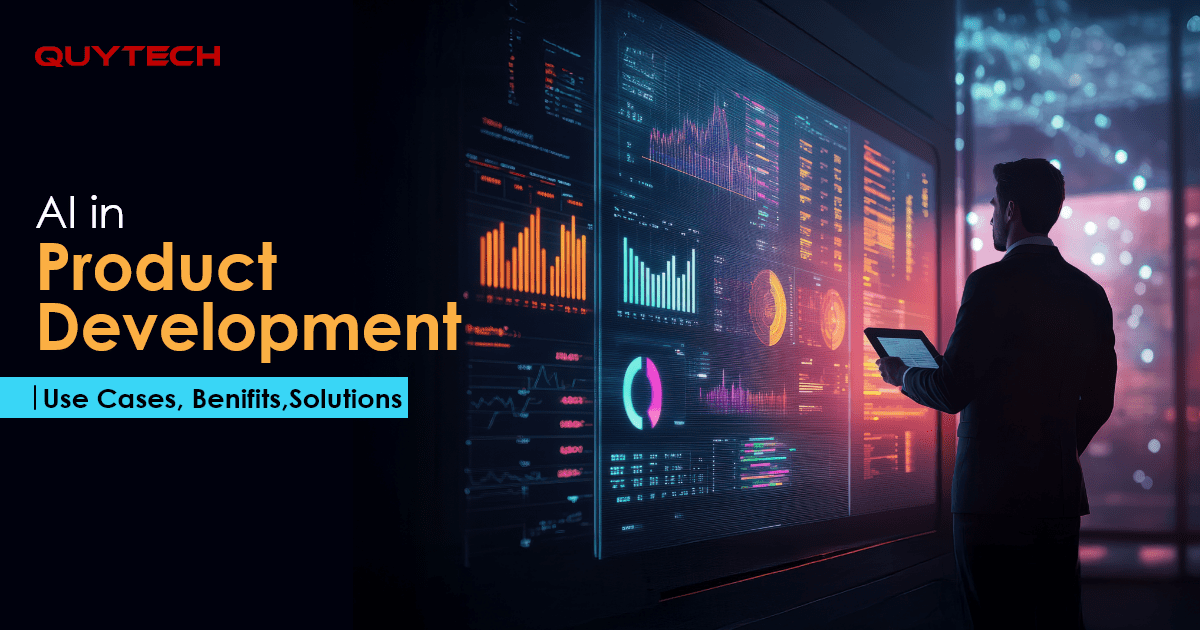What comes to your mind when you are asked about the product development life cycle? The first thought will probably be about the slow, manually done traditional stages from ideation to deployment and improvement. This is how things worked before Artificial Intelligence was introduced, but not anymore!
AI has brought in a wave of evolution for every stage of the product development life cycle. The ideas and designs that once took days to create are now done in minutes. The transformation is brought by advanced tools like Generative AI, machine learning, natural language processing, and much more. These AI-powered tools have made the product development process much faster.
Fascinating, isn’t it? If you are curious about the wonders brought in by AI in product development, then you are at the right place. Read this blog and explore everything from the basics to the brilliance of the product development life cycle.
AI in Product Development: What Does It Mean?
As you may already know, the process of developing a product goes all the way from market research to post-deployment maintenance. In all these phases, product developers and managers face numerous roadblocks. This is where AI tools for product development play their role and make this bumpy ride a smooth one.
AI in product development brings in tools and technologies that help businesses throughout the process:
- In the initial stages, AI tools for product development help in conducting efficient market analysis and understanding customer needs and feedback.
- Once the market is analyzed, AI in product development assists in designing the UI/UX and developing prototypes.
- When the process reaches the stage of development, AI tools help in generating code and catching errors.
- Post-development, AI in product development assists in automating the testing process. This ensures smooth deployment and predicts maintenance needs.
AI in Product Development: How It Works and Transforms the Process
Wondering how AI in product development works? Dive into this section to see how it’s transforming everything from design to delivery:
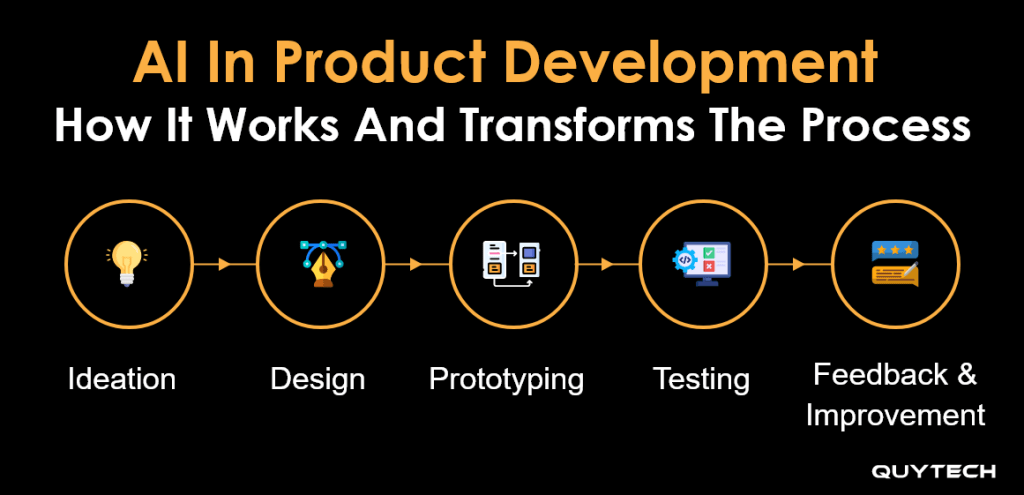
Ideation
Traditional product development processes depended on brainstorming and manual research for idea generation. The data used for idea creation was often limited, restricting ideas and productivity.
AI in product development uses methods like data mining, trend, and pattern analysis. This helps in backing the ideation process with data-driven insights.
Design
Without AI, the designing step was done using manual wireframes. As a result, designs were often ineffective, and even the faults were not noticed till later stages. This not only wastes resources but also the efforts of the development team.
The AI-driven approach utilizes machine learning and generative AI to predict user behaviour and create a personalized design.
Prototyping
The traditional approach of prototyping involved creating multiple prototypes and testing them one by one. This process wasted a lot of resources and was not cost-efficient.
AI tools for product development use reinforcement learning for prototyping. The transformation here allows faster prototype creation. These prototypes update automatically.
Testing
The testing process was done physically in the traditional setting, consisting of multiple manual testing rounds. The process was so tedious that it used to take weeks and even months to approve a software.
It uses advanced technologies like computer vision, machine learning, and automated testing to detect bugs and errors.
Feedback & Improvement
Back when AI tools were not used, the feedback was collected through manual surveys and reviews. Collecting feedback was only half the challenge; analyzing it was another. This was also done manually, and sometimes the process overlooked key insights.
With AI tools like real-time analytics, natural language processing, and machine learning models, improvements are made faster based on user behaviour.
Benefits of AI in Product Development
The introduction of AI in product development made the process much quicker and decreased the workload by automating repetitive tasks. Here are some benefits of AI in product development:
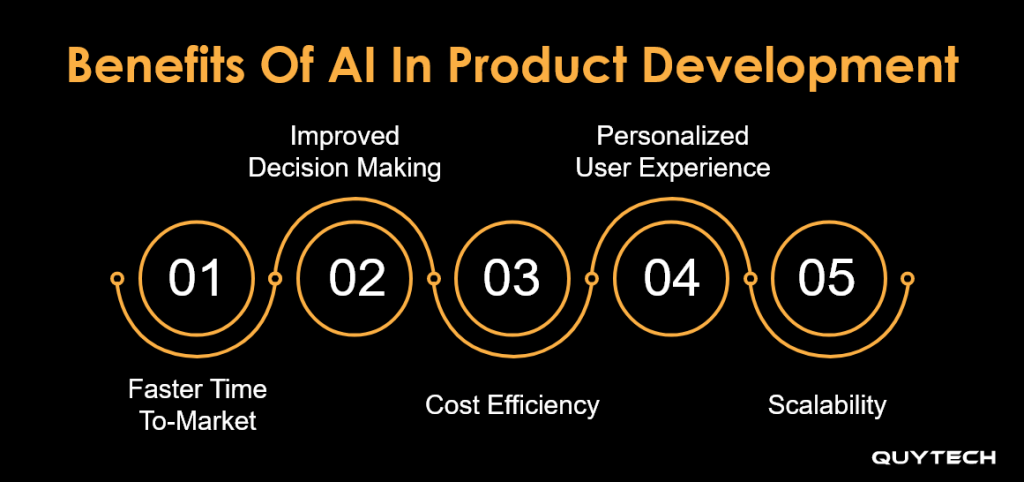
Faster Time-to-Market
The introduction of AI in product development reduced the time spent on completing time-consuming tasks like designing, testing, updating, etc. This means that the product makes it to the market faster.
Improved Decision Making
AI in product development improved the decision-making process. Earlier, the decisions were made based on assumptions. But with AI tools for product development, the decisions are now made based on data-backed insights.
Cost Efficiency
Building a product without the help of artificial intelligence used to cost comparatively more. After AI tools were utilized, most processes became automated and faster. This saved the resources, tools, and hiring costs.
Personalized User Experience
AI tools for product development utilize data analysis to understand the user expectations from a product. This analysis helps in providing data-driven insights. With these insights, businesses can develop products that feel personal to the users.
Scalability
Another benefit of utilizing AI-powered product development is easy scalability. AI tools ensure that the product developed is capable of upscaling when the user base increases. AI in product development enables easy scalability without compromising on quality.
Read More: How AI Agents are Redefining Enterprise Productivity
Solving Product Innovation Challenges with AI
If you ask product managers about the product development process, they will tell you that it’s not a piece of cake. Things often take a very unexpected turn. There are times when the actual product may not come out as planned.
This is why the product development process takes most of the time and the efforts of product managers. Here are some challenges that businesses face during the product development life cycle, along with the ways AI solves them:
Lack Of Direction Clarity
The human brain is very capable but has its limitations. When working on product development, there can be a lack of direction clarity as the initial stages are based on human insights and assumptions.
However, with AI tools for product development, the direction is guided by insights driven by AI data analysis.
Innovation Stagnation
As already mentioned, the human brain has its limitations; one can face innovation stagnation when they decide on product features. And if the innovation is not revived timely manner, the features can be repetitive, and the production process can get delayed.
AI in product development brings in generative tools that help in providing innovative ideas, features, and concepts.
Disorganized Feedback
One very prominent challenge that holds innovation back is disorganized feedback. A product is what the user perceives it as. And to know this perception, feedback is gathered from reviews, ratings, suggestions, surveys, etc. But all of these are scattered and disorganized, making it hard to work on the feedback.
AI-powered product development utilizes tools like natural language processing to analyze the feedback from various sources and provide improvement insights.
Scalability Challenges
As the user base increases and expansion takes over, scalability becomes. This means the same product will now cater to a wider audience. But was it built for that? Manual developed products are often not capable of scaling without slowing down or breaking down.
AI solves this challenge by automating repetitive tasks, optimizing tasks, and updating smoothly. This makes scalability an achievable goal.
Similar Read: AI Agents Vs. Traditional Automation: A Detailed Comparison
AI in Product Development: Key Use Cases
Now that you are familiar with most of AI in product development, let’s walk you through its key use cases:
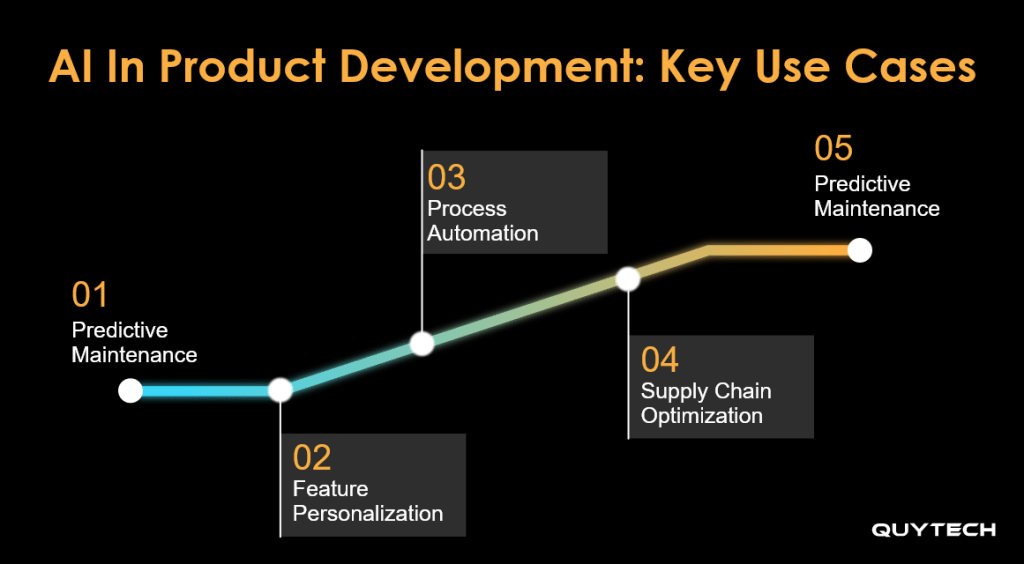
Predictive Maintenance
AI can monitor the product development process to ensure that nothing goes wrong. It predicts failures beforehand by analyzing the data collected. This saves time, effort, and resources.
Real-Life Example
- BMW utilizes AI-powered data analytics to predict maintenance needs from data collected through production lines.
- Predictive tyre maintenance and analytics solution developed by Quytech helps in overcoming inefficient tyre maintenance practices.
Feature Personalization
The feature personalization use case of AI allows businesses to cater to their customers at a more personal level. This helps in meeting their expectations effectively by providing a personalized experience.
Real Life Example
- Spotify utilizes AI to understand user preferences and offer personalized experiences.
Process Automation
Process automation uses artificial intelligence tools like robotic process automation, NLP, etc. These tools help in automating repetitive tasks without much human dependence.
Real Life Example
- Google utilizes process automation to automate Android update testing.
- Praavi HRMS software, developed by Quytech, utilizes automation to automate attendance tracking, payroll processing, and compliance management.
Supply Chain Optimization
Artificial intelligence in supply chain management analyzes data to provide insights. These insights are then used to manage inventory, enhance the planning process, and improve the overall process.
Real Life Example
- Amazon utilizes AI to improve warehouse management and delivery route optimization.
Virtual Prototyping & Simulation
Virtual prototyping uses artificial intelligence to build a digital prototype for testing instead of creating a physical prototype. This helps in saving time, effort, and costs spent on developing physical prototypes.
Real Life Example
- BMW tests assembly lines using AI-powered virtual factories.
How to Integrate AI Into Your Product Development Process
Integrating AI into your product development life cycle is a very smart step that can help businesses in revving up their games. The following steps define the process of integrating AI into your product development process:
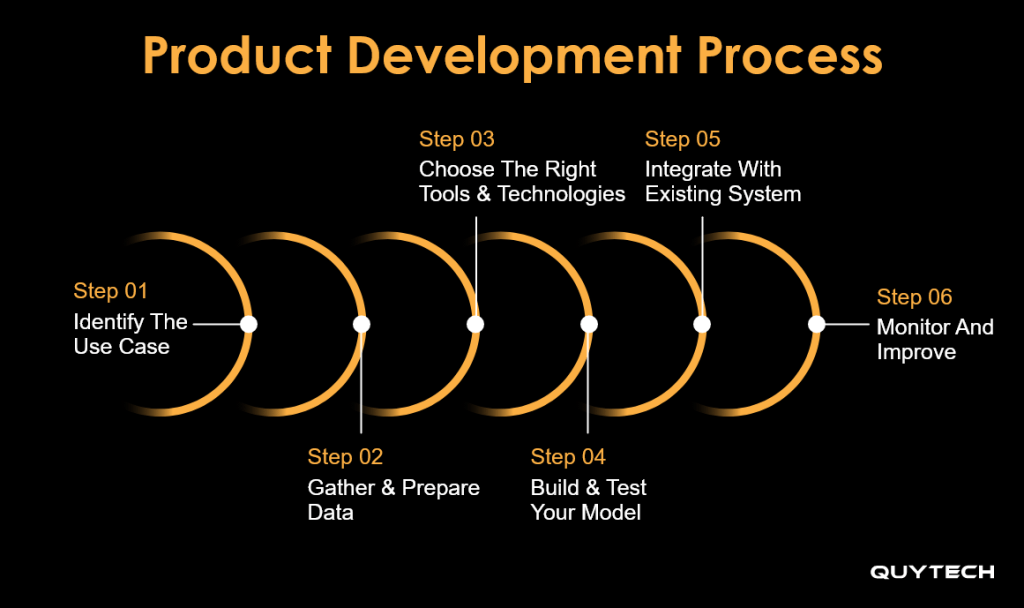
Step 1: Identify the Use Case
Firstly, to integrate AI into your product development process, you need to identify the use cases where you want it to help. This can be for automation, decision making, designing, personalization, etc.
Step 2: Gather and Prepare Data
Once you have identified the use cases, start gathering the data and resources you need to proceed with the implementation process. You can gather this data from your customers, product, or the market.
Step 3: Choose the Right Tools and Technologies
Now that you have the use case and the data, decide on the tools and technologies that will utilize them effectively. If your product will handle visuals, go with computer vision. If your product will handle automation, go with RPA.
Step 4: Build & Test Your Model
Once all the required tools, technology, and resources are gathered, begin the process of development. You can build either from scratch or utilize ready-made models. After developing, thoroughly test your model.
Step 5: Integrate with Existing System
In this step, you will blend everything in. This means that you will integrate your model with the existing structures and systems. Integration should be done in a way that everything works smoothly.
Step 6: Monitor and Improve
The process of integrating AI in your product development process does not end here. After integration, keep monitoring your AI model’s performance. Collect feedback, fix issues, and keep improving the model.
Similar Read: How Does AI Video Analytics Help Detect Threats in Real Time?
Legal and Ethical Considerations While Using AI in Product Development
Every tool and technology brings its share of conditions. Here are some legal and ethical considerations that you must keep in mind while using AI in product development:
Data Privacy & Protection
AI in product management utilizes the user data collected from various sources. This data helps in making improvement decisions regarding the product. Businesses should ensure that when they use the data, it does not compromise privacy and protection.
Regulatory Compliance
As AI tools like machine learning and natural language processing, etc, utilize data to train. It should be kept in mind that you follow the required industry-specific rules and regulations.
Liability & Accountability
AI is powerful and accurate, but that does not mean that it cannot make mistakes. The company should keep in mind that if an AI tool makes any mistake while developing or handling the product, the responsibility and accountability for it are in their hands.
Bias & Fairness
As you already know that AI trains on data. Many times, the data provided to it is biased. When trained on that data, it gives the outcomes, which may not be fair and may reflect bias. To ensure fairness, companies must use balanced data and keep a check on the outcomes as well.
Transparency
As AI is capable of analyzing, understanding, and comparing situations, it automates its decision-making process. Automating decisions is not the issue; the consideration here is that it should be able to explain the reason behind its decisions. This will offer transparency and help build user confidence.
Misuse Prevention
AI brings in a lot of tools. These tools are able to generate and provide hyper-realistic outcomes. Developers must ensure that they build secure and regulated solutions during the product development life cycle. This will help in preventing misuse of the technology.
Future Trends of AI in Product Development
Just as AI is transforming product development today, the technology itself will continue to evolve. This evolution will give rise to new trends in the future. Here are some of them:
Hyper-Personalized Products
A very prominent future trend in AI product development is hyper-personalized products. This trend will create solutions so personalized that users will feel they were made just for them.
AI-Powered Autonomous Design
Another immersive future trend is AI-powered autonomous design. This trend will automate the process of designing products and will require very minimal help from human operators.
Digital Twins
Digital twins refer to a digital version of a product. This trend will be widely used in the future. Companies will utilize digital twins to create and test a product without actually developing it.
Sustainable Development
More and more industries and businesses are shifting towards AI. This shift will promote the use of AI tools in a way that is safe for the environment. It will suggest using less waste-generating and energy-consuming designs and materials.
You might also like: AI Data Analytics for Supply Chain Risk Management
Quytech’s Role in Shaping AI-Powered Product Development
Quytech brings in talent along with experience. With over 14 years of domain expertise, we help businesses build solutions that are scalable and tailored to your needs. Our team closely communicates every step of integrating AI in your product development process to ensure transparency and high-quality delivery.
Our success stories reflect our dedication towards delivering quality AI solutions. With AI-driven solutions like Praavi HRMS, Synapse AI, and much more, Quytech brings your idea to reality.
Conclusion
Integrating AI in product development is no longer a fancy thing. It has become so prominent that nearly 92% of companies plan to increase their investment in AI. In the product development life cycle, AI plays a significant role.
It utilizes advanced technologies like machine learning, gen AI models, computer vision, NLP, etc. These technologies facilitate the same product development process, but smartly. With benefits like cost efficiency, faster time to market, better decision making, and scalability, AI in product development is the transformation every business needs.
FAQs
Not necessarily, you can implement AI in your product even with small amounts of data. But having large amounts of data can help in training your AI better.
The duration for integrating AI into a product depends on the complexity of the product and the features you want to integrate. Simpler models take less time as compared to complex ones.
Yes, using AI in product development can help you cut operational costs as AI can facilitate automation and save a lot of time.
Yes, you can integrate AI in product development without an in-house tech team by hiring developers or partnering with an AI development company.
